
The Savinja is a river in northeast Slovenia which flows mostly in the Upper and Lower Savinja Valley and through the cities of Celje and Laško. The Savinja is the main river of the Savinja Alps. It flows into the Sava River at the town of Zidani Most. It has often flooded, such as in the 1960s, 1990, and 1995. The Savinja has a length of 101.75 kilometres (63.22 mi) and a catchment area of 1,847.7 km2 (713.4 sq mi).

The Drava or Drave is a river in southern Central Europe. With a length of 710 kilometres (440 mi), 724 kilometres (450 mi) including the Sextner Bach source, it is the fifth or sixth longest tributary of the Danube, after the Tisza, Sava, Prut, Mureș and perhaps Siret. Its source is near the market town of Innichen, in the Puster Valley of South Tyrol, Italy. The river flows eastwards through East Tirol and Carinthia in Austria into the Styria region of Slovenia. It then turns southeast, passing through Croatia and, after merging with its main tributary Mur, forms most of the border between Croatia and Hungary, before it joins the Danube near Osijek.

The Mur or Mura is a river in Central Europe rising in the Hohe Tauern national park of the Central Eastern Alps in Austria with its source being 1,898 m (6,227 ft) above sea level. It is a tributary of the Drava and subsequently the Danube.

The Meža (Slovene) or Mieß (German) is a river in the Austrian state of Carinthia and in Slovenia, a right tributary of the Drava. It is 43 km long, of which 42 km in Slovenia. Its catchment area is 551.7 km2, of which 543 km2 in Slovenia.
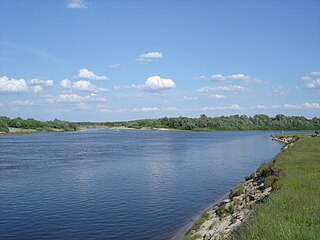
Moksha is a river in central Russia, a right tributary of the Oka River. It flows through Penza Oblast, Nizhny Novgorod Oblast, Ryazan Oblast and the Republic of Mordovia, and joins the Oka near Pyatnitsky Yar, below the city of Penza Oblast.

The Vilnia is a river in Lithuania. Its source is near the village of Vindžiūnai, 5 km south of Šumskas, at the Lithuanian-Belarusian border. The Vilnia is 79.6 km long and its basin covers 624 sq. km. For 13 km its flow makes the Belarus-Lithuania border, and the remaining 69 km are in Lithuania until it flows into the Neris River at Vilnius. Eventually, its waters, via the Neris's drainage into the Neman River, flow into the Baltic Sea. Its confluence with the Neris lies within the city of Vilnius, and the river's name was probably the source of the city's name.
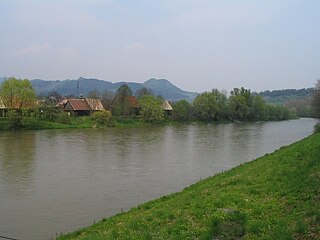
The Orava is a 60.9 km long river in north-western Slovakia passing through a picturesque country, in the Orava county. Its source is nowadays the Orava water reservoir whose waters flooded the confluence of Biela (White) Orava and Čierna (Black) Orava in 1953. It flows into the river Váh near the village of Kraľovany.

The Vézère is a 211-km-long river in southwestern France. It is an important tributary to the Dordogne River. Its source is in the northwestern part of the elevated plateau known as the Massif Central. It flows into the Dordogne near Le Bugue. A tributary of the Vézère is the Corrèze River.

The Sutla (Croatian) or Sotla (Slovene) is a river flowing through Slovenia and Croatia, mostly forming their border. It is a tributary to the Sava, itself a tributary to the Danube. It is 89 kilometres (55 mi) long and has a watershed area of 584 square kilometres (225 sq mi).

The Kupa or Kolpa river, a right tributary of the Sava, forms a natural border between north-west Croatia and southeast Slovenia. It is 297 kilometres long, with its border part having a length of 118 km (73 mi) and the rest located in Croatia.

The Krka is a river in southeastern Slovenia, a right tributary of the Sava. With a length of 94.6 km (58.8 mi), it is the second-longest river flowing in its entirety in Slovenia, following the Savinja.

The Ščavnica is a 56-kilometer (35 mi) river in Styria, Slovenia. It sources near Zgornja Velka and flows along the Slovene Hills towards the southeast. It passes Negova Castle and Sveti Jurij ob Ščavnici, traverses Lake Gajševci and the town of Ljutomer, and finally joins the Mur from the right in Razkrižje.

The Vipava or Vipacco or Wipbach / Wippach is a river that flows through western Slovenia and northeast Italy. The river is 49 kilometres (30 mi) in length, of which 45 km in Slovenia. After entering Italy it joins the Isonzo/Soča in the Municipality of Savogna d'Isonzo. This is a rare river with a delta source, formed by nine main springs. The Battle of the Frigidus was fought near the river, which was named Frigidus ('cold') by the Romans. It has the pluvial-nival regime in its upper course and the pluvial regime in its lower course.
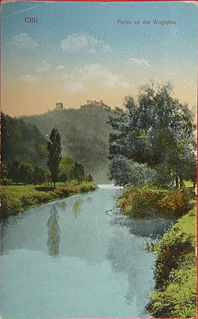
The Voglajna is a river in Styria, Slovenia. The river is 35 kilometres (22 mi) long, and its catchment area is 412 km2 (159 sq mi). Its source is Lake Slivnica near Slivnica pri Celju. It passes Šentjur, the ruins of Rifnik Castle, and Štore, and then merges with the Savinja River in Celje.
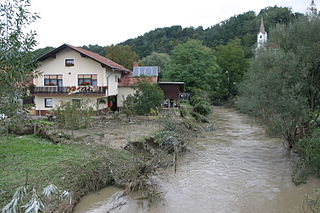
The Hudinja is a river in Styria, Slovenia. The river is 32 kilometres (20 mi) in length. Its source is on the Pohorje Massif southwest of Mount Rogla, about 1380 m above sea level, near the source of Dravinja River. The river passes Vitanje, Socka Castle, Vojnik, and Celje, where it flows into the Voglajna. A district of Celje also named Hudinja lies on the river.

Zgoša is a settlement in the Municipality of Radovljica in the Upper Carniola region of Slovenia.

Dol is a small settlement in the Upper Dreta Valley in the Municipality of Gornji Grad in Slovenia. Traditionally the area belonged to the Styria region and is now included in the Savinja Statistical Region.

Potok is a small village on the right bank of the Dreta River in the Municipality of Nazarje in Slovenia. Traditionally the area belonged to the Styria region and is now included in the Savinja Statistical Region.

Orljava is a river in Slavonia, eastern Croatia, a left tributary of Sava. It is 87.6 kilometres (54.4 mi) long and its basin covers an area of 1,618 square kilometres (625 sq mi).
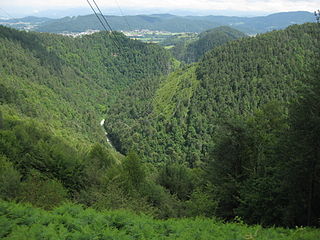
The Besnica is a stream that flows through the Besnica Valley east of Ljubljana. It flows through the scattered settlement of Besnica and empties into the Ljubljanica at Podgrad as its last right tributary just before it joins the Sava River. In the past, this was also the quadruple confluence of the stream with the Sava, Kamnik Bistrica, and Ljubljanica rivers.























